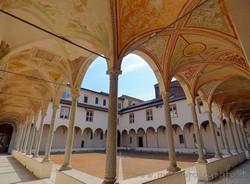|
Cloisters of San Simpliciano
|
|
|
Show an other treasure of art and history in Milan:
|
 Mostly represented styles: Renaissance - Baroque Mostly represented styles: Renaissance - Baroque
The Cloisters of San Simpliciano represent one of the many secret corners of Milan, almost completely unknown not only to the many tourists who visit Milan, but also to most of the Milanese themselves.
Originally they were part of the Convent of San San Simpliciano, associated with the ancient Basilica of San Simpliciano.
Currently there are two cloisters, the Chiostro Piccolo ("Small Cloister"), leaning against the bell tower, and the Chiostro Grande ("Large Cloister"), also known as the "Cloister of the two columns". Originally there was also a third cloister, but it was lost.
Small Cloister
Also known as the Painted Cloister, it is the oldest cloister. It was built in the last quarter of the fifteenth century, by order of Leonardo del Maino, "commendatory" abbot of the Convent of San Simpliciano. However, it was completed only after the death of Maino's successor, Giovanni Alimenti Negri. Both were "commendatory" abbots as they were people who did not come from inside the convent and who were on the contrary imposed by the secular authorities, in this case by the Visconti first and by the Sforza later, on the basis of political criteria instead of devotional ones.
The presence at the head of the monastery of commendatory abbots led to a progressive worldliness of the convent. Accordingly, the Chiostro Piccolo appears like a patrician cloister. It is a rectangular space surrounded by porticos of nine and ten slender stone columns, currently resting on a low wall and ending with a palm-leaf capital bearing large arches.
The flooring is in terracotta, in a herringbone pattern.
The arcades are covered by cross vaults. A significant part of the fresco decoration of the vaults (in typical Renaissance style, with grotesque decorations divided into triangular, rectangular and round panels, different in each span) is still present.
Unfortunately, the frescoes by Ambrogio da Fossano known as il Bergognone have been lost. They were made after the death in 1499 of the abbot Giovanni Negri using the donation to the convent present in his will. In them the lives of the martyrs of Anaunia, Sisinio, Martino and Alexander, were told in images.
The last restorations have however allowed to bring to light fragments of trompe l'oeil monochrome frescoes on the walls of the first floor.
Cloister of the Two Columns
The construction of the Cloister of the Two Columns is connected to the passage in 1517 of the basilica and the convent to the Cassino Benedictines (Benedictines of Monte Cassino). This change led not only to a financial restoration of the convent, but also to a spiritual and moral rebirth. This led to an increase in the number of monks so that a new cloister had to be built. Work began in 1563 but the full completion was achieved only in the eighteenth century.
Unlike the older cloister, this was thought like as a monastic cloister. The project is probably due to Vincenzo Seregni. It is a square, wide and rather massive building.
The arcades are very wide and delimited, towards the central area, by coupled stone columns a little less than two meters high placed on a low wall and equipped with a Doric capital. The capitals support a small stone architrave from which the arches start.
The courtyard of the cloister has five fountains: one in the center, larger, and four on the four sides. Currently its area is divided into sixteen rectangular flower beds bordered by hedges and interspersed with gravel paths.
The arches support the first floor, marked by the close succession of many equal rectangular windows, interspersed with pilasters and surmounted by arches in relief. Between each arch and window there is a trompe l'oeil representation of a bust of a saint above a low pedestal. Unfortunately almost all of these figures are now illegible.
Monumental staircase
Completed at the beginning of the eighteenth century, it connects, with its two ramps, the ground floor with the noble floor. The project is attributed to the architect Francesco Maria Richini. The staircase is adorned by the busts of San Gregorio Magno, Beda the Venerable, San Giovanni Damasceno and San Pier Damiani.
From the end of the eighteenth century, with the suppression of the convent, the cloisters were for a long time used as barracks and even as a shooting range. Only in 1939 they returned to an ecclesiastical destination and the barracks housed in them were dismantled.
Until 1967 they were entrusted to the Equestrian Order of the Knights of the Holy Sepulcher. After this date they became the headquarters of the Theological Faculty of Northern Italy.
As a rule the Cloisters of San Simpliciano are not open to the public, except for special events and exhibitions.
It should be emphasized that the Small Cloister allows you to see the back of the basilica, otherwise not visible.
If you are interested in a guided tour of this monument send an email!
Categories: Churches / Religious buildings Others
Piazza S. Simpliciano, 7, 20100 Milano MI |
Further pictures of the Cloisters of San Simpliciano in the section Photography |